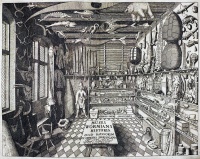Curiosa
From The Art and Popular Culture Encyclopedia
(Difference between revisions)
| Revision as of 07:50, 6 March 2018 Jahsonic (Talk | contribs) ← Previous diff |
Revision as of 07:50, 6 March 2018 Jahsonic (Talk | contribs) Next diff → |
||
| Line 1: | Line 1: | ||
| [[Image:Musei Wormiani Historia.jpg|thumb|right|200px|"[[Musei Wormiani Historia]]", the [[book frontispiece|frontispiece]] from the ''Museum Wormianum'' depicting [[Ole Worm]]'s [[cabinet of curiosities]]]] | [[Image:Musei Wormiani Historia.jpg|thumb|right|200px|"[[Musei Wormiani Historia]]", the [[book frontispiece|frontispiece]] from the ''Museum Wormianum'' depicting [[Ole Worm]]'s [[cabinet of curiosities]]]] | ||
| {{Template}} | {{Template}} | ||
| - | :''[[curious]], [[bibliophily]], [[cult fiction]], [[Curiosities of Literature]]'' | ||
| '''Curiosa''' is most commonly used for [[books]] or other writings dealing with [[unusual]], especially [[pornographic]] and [[erotic]] topics. It is derived from the term ''[[curious]]''. | '''Curiosa''' is most commonly used for [[books]] or other writings dealing with [[unusual]], especially [[pornographic]] and [[erotic]] topics. It is derived from the term ''[[curious]]''. | ||
| In [[1887]] [[Alcide Bonneau]] collected a number of his essays and published them as ''[[Curiosa: essais critiques de littérature ancienne ignorée ou mal connue]]'', it is said that the later bookselling category ''[[curiosa]]'' thanks its coinage to this collection. Before Bonneau, [[Isaac D'Israeli]] had published ''[[Curiosities of Literature]]'' (4 vols. [[1791]]-[[1823]]; single vol. [[1824]]), a collection of [[anecdote]]s about historical persons and events, [[unusual]] books, and the habits of [[book-collector]]s. | In [[1887]] [[Alcide Bonneau]] collected a number of his essays and published them as ''[[Curiosa: essais critiques de littérature ancienne ignorée ou mal connue]]'', it is said that the later bookselling category ''[[curiosa]]'' thanks its coinage to this collection. Before Bonneau, [[Isaac D'Israeli]] had published ''[[Curiosities of Literature]]'' (4 vols. [[1791]]-[[1823]]; single vol. [[1824]]), a collection of [[anecdote]]s about historical persons and events, [[unusual]] books, and the habits of [[book-collector]]s. | ||
| == See also== | == See also== | ||
| + | :''[[curious]], [[bibliophily]], [[cult fiction]]'' | ||
| *''[[Curiosities of Literature]]'' by Isaac D'Israeli | *''[[Curiosities of Literature]]'' by Isaac D'Israeli | ||
| * [[Jules Gay]], a publisher of curiosa | * [[Jules Gay]], a publisher of curiosa | ||
Revision as of 07:50, 6 March 2018

"Musei Wormiani Historia", the frontispiece from the Museum Wormianum depicting Ole Worm's cabinet of curiosities
|
Related e |
|
Featured: |
Curiosa is most commonly used for books or other writings dealing with unusual, especially pornographic and erotic topics. It is derived from the term curious. In 1887 Alcide Bonneau collected a number of his essays and published them as Curiosa: essais critiques de littérature ancienne ignorée ou mal connue, it is said that the later bookselling category curiosa thanks its coinage to this collection. Before Bonneau, Isaac D'Israeli had published Curiosities of Literature (4 vols. 1791-1823; single vol. 1824), a collection of anecdotes about historical persons and events, unusual books, and the habits of book-collectors.
See also
- Curiosities of Literature by Isaac D'Israeli
- Jules Gay, a publisher of curiosa
- BiblioCuriosa, a wiki dedicated to such literature
- Curious
- Cabinet of curiosities
- Bizarre
- Facetious
- Physica Curiosa (1662) - Gaspar Schott
Unless indicated otherwise, the text in this article is either based on Wikipedia article "Curiosa" or another language Wikipedia page thereof used under the terms of the GNU Free Documentation License; or on research by Jahsonic and friends. See Art and Popular Culture's copyright notice.

